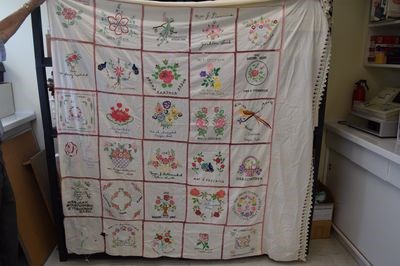A Canora man has come into possession of a historic quilt sewn by rural women as therapy during the Second World War.
John Oystryk is the new owner of a 60 inch by 70 inch bed cover originally embroidered by women in the Canora area in 1942 and 1943, after receiving it from Karen Bauer, who had retrieved the fabric from her mother.
Oystryk said the story of finding the quilt was a chain of events.
“The story began with reading an obituary in an area paper,” he said.
The obituary detailed the recent passing of Mary Koroluk, a woman who was one year younger than Oystryk. They were childhood friends, and grew up on farms one mile apart from each other while attending Cedric School in the 1930s. Oystryk discovered that she had started a hairdressing business before returning to help her father after her mother’s passing. She farmed about 120 miles southeast from the area they grew up in. The obituary made mention of Bauer, so Oystryk made a phone call to her.
“I expressed my sympathy for the loss of her mother, and then told her that I had something regarding her mother that she might like to have,” Oystryk said.
The article in question was a clipping from a Yorkton paper regarding the homestead house of Koroluk’s grandparents, John and Helena Todoschuk, which was a thatched roof house Koroluk was born in. On top of that, Oystryk also had copies of the Cedric School registry. He sent the information over to Bauer, who he said felt “very good to have the papers about her mother.”
Bauer also gave Oystryk a bit of a surprise when she said that she had a gift to thank him.
“My first thought was, ‘what could she possibly have for me?’” Oystryk said.
He quickly discovered that Bauer had been holding all of her mother’s items she left at the care home and found the blanket as part of it. He and Bauer met in March 2015, and she gave the quilt to him.
“She knew that I had done research in the past, and because she didn’t know anyone whose name was on the blanket aside from her mother’s, she thought that I may know some of them and could put some information together to take to a museum.”
Oystryk said he was happy to do it, and worked over the course of 15 months to put together an explanation of the item’s history.
The cloth is made up of 10-inch square pieces of fabric sewn together, as well as two eight-inch pieces of material knitted onto the top and right of the blanket and trimmed with lace. A total of 29 of the 30 embroidered squares hold names of various women from Stornoway, Veregin, Yorkton, Kamsack, Dneiper, Rhein, Theodore, Foam Lake, and Windsor, Ont.
Oystryk has come up with an interesting theory for the bed cover’s creation regarding therapy. In 1942, Dr. Peter Polotski, a family doctor in Yorkton, had noticed that there was an increase of women coming to his office needing medical assistance. They were beginning to suffer anxiety and depression, due to the fact that many of their male relatives were serving in the war.
“These women were afraid they may never see their husbands, sons, and brothers back home again, which made the doctor feel that they were under severe mental stress,” Oystryk said. The theory is that Polotski then began organizing meetings for the women one evening per week, and that the women sewed the blanket as a way to relieve their stress. The names embroidered on the cloth, Oystryk says, were often written ‘Mrs. Joe Smith’. This is because the tradition at the time was for women to sign their names with their husbands’ names, so that people who needed money, such as general store owners who let women buy food without immediate payment, could seek out the man as the family leader.
Oystryk says that, following approval by Bauer, he hopes to take the blanket to a museum in order to showcase the struggles women faced living through the Second World War.




